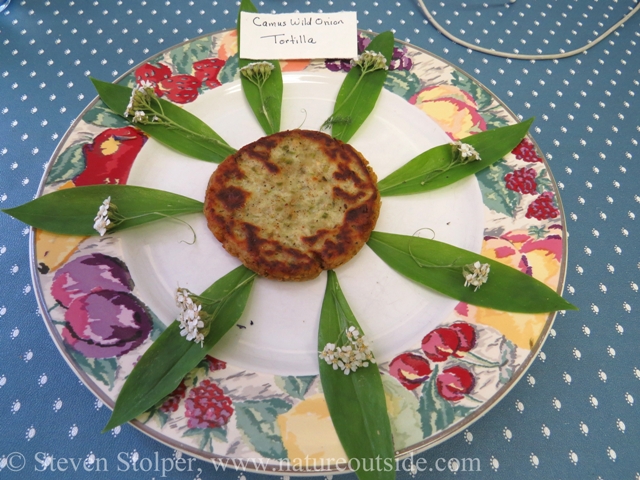
Wild edible plants intrigue me. The idea of snacking on edibles while walking down the trail appeals to me in a primal way. Most of us explore the outdoors with our sight, smell, and hearing. But you can also use your sense of taste! How better to integrate yourself into your surroundings?
I started by choosing one or two easily identifiable species. I studied them intensely to get to “know” the plants. Then I learned the environmental questions to ask to determine if it is safe to harvest a particular specimen.
As I learned more about wild plants, I discovered that many people take it to the next level. They harvest wild edibles as a regular part of their diet. I like the idea that our local environment can help feed us. It also appeals to my inner-cheapskate, who can never turn down a free meal. Practiced with respect and care for our environment, eating wild edible plants can open a new dimension in your exploration of nature.
Cooking up a storm
This is a post in my Sierra Nevada Field Camp series. I was fortunate to take a class where we spent two days foraging for edibles and a day and a half processing and cooking. Many of the students in the class were just beginning with edible plants. But their enthusiasm and creativity really shined when it came time to prepare the food!
This post shows some of our finished products. We prepared a lunch to serve to the entire field camp on the last day of class. I hope that by showing our finished dishes I can give you some ideas to inspire your inner Julia Childs.
Disclaimers
- This post describes my experience preparing food from plant material. I was under the supervision of experienced teachers at all times. Use common sense and get training from a respected expert before identifying and consuming wild edibles on your own. Learn what you are doing first!
- All plant materials were harvested responsibly and where permitted by law.
- All factual errors are mine! My handwritten notes look like hieroglyphics. 🙂 Do your own research!
Camus (Camassia quamash)
This Camus is edible. Two poisonous look-alikes in the area are nicknamed “Death Camus” (Zigadenus). Do not get them confused! It could ruin your post-meal plans.
We consumed the root of the plant. These roots were slow-cooked in a crockpot.
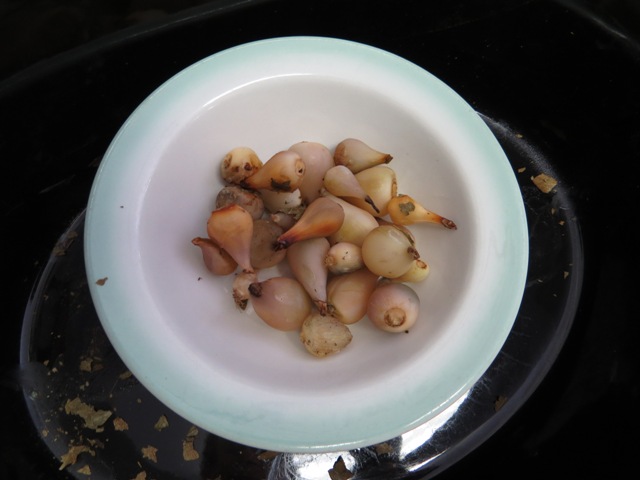
Camus roots (cooked)
We also mashed the Camus roots and mixed them with Swamp Onion to form what I would call a potato pancake. We called it a “Camus Wild Onion Tortilla”.

Camus and Wild Onion
Yampah (Perideridia)
Yampah are in the Apiaceae family and have umbels of white flowers. In my experience, they grow in dryer areas at higher altitudes than other members of their family. Habitat is one clue I use to avoid a dangerous misidentification.
This plant is plentiful, although a field guide I read said there was a time they were very rare due to over-harvesting by the indigenous peoples.
Yampah makes me think about survival food strategies. The edible root is very small. The largest I found were the size of two peanut M&Ms stuck together. One of the students in the class opined, “This is a waste of time and energy” as we dug roots. But I think otherwise. You can expend a lot of energy for a big payoff (i.e. hunting or digging deep roots) or a small amount of energy for a small payoff that is plentiful. I would rather have the small, plentiful, food source that requires little energy to exploit. It seems like a more stable survival strategy.
The root can be eaten raw or cooked. The raw root has that distinctive Apiacae-like taste. When cooked, the taste diminishes and a potato-like flavor challenges. I like both, but the cooked root tasted more like “energy”.
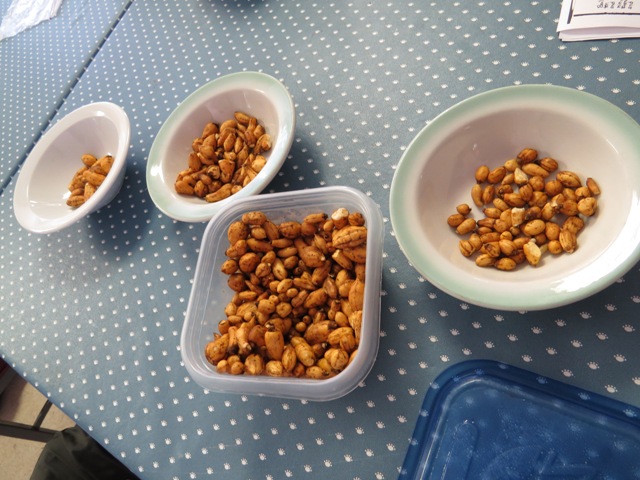
Yampah raw
We mashed the Yampah and treated it like mashed potatoes. We made two dishes. One was savory and consisted of swamp onion and other herbs. The other was sweet and included cinnamon and monkey flower. We formed the mashed Yampah into “meatball” sized balls and served. Below is the savory Yampah. Yes, I know what kind of leaf it is on! It is Cow Parsnip. That was not my idea.
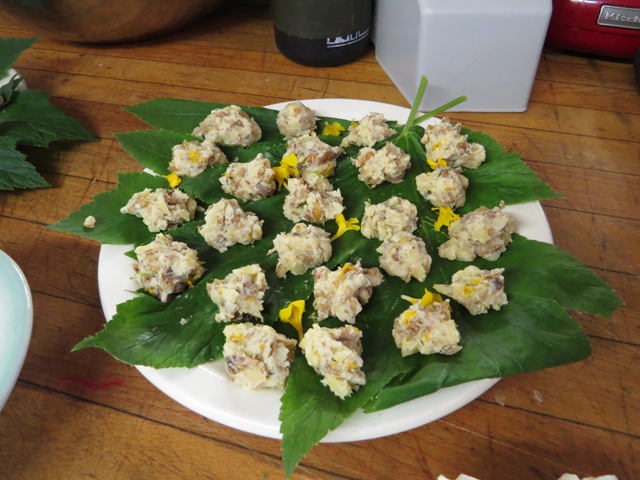
Mashed Yampah (savory)
Elderberry
What is a wild edibles meal without Elderflower Fritters?…
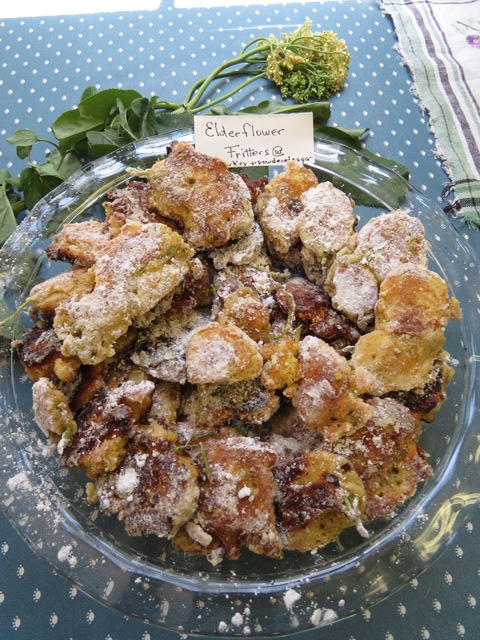
Elderflower fritters
We also had Elderberry Scones.
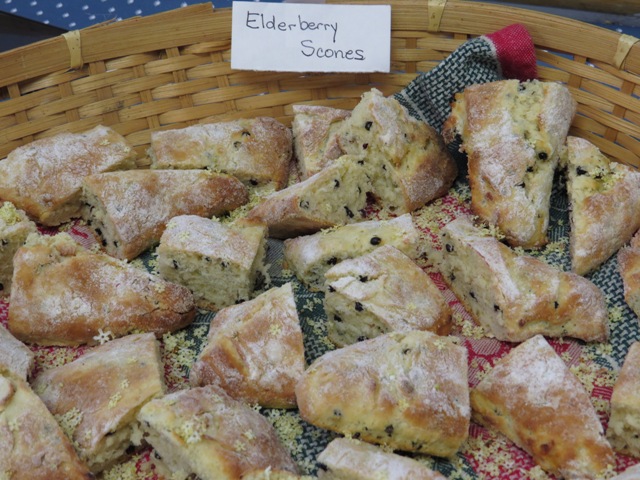
Elderberry scones
Cattail/Reed Mace
We steamed cattail heads like corn on the cob. We used both parts of the head – male and female. With melted butter it was delicious!!!
You eat it like corn on the cob, too. When you are done eating you are left with a straw-like stem.
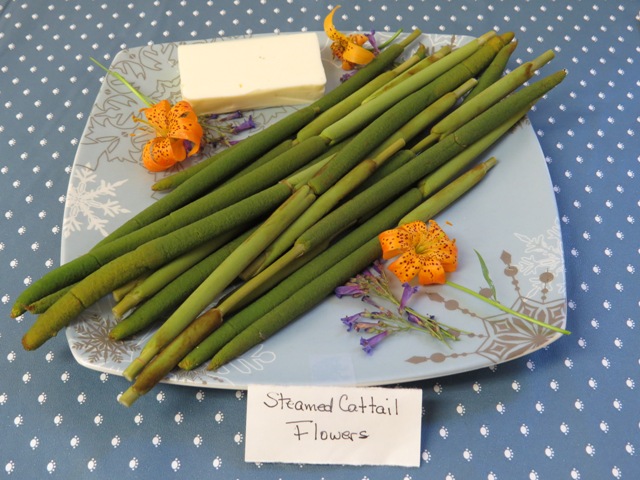
Steamed cattail heads
I was eager to collect some rhizomes. But the instructors talked me out of it. They said it was a wet, dirty job and that “Every cattail is connected to every other cattail… in the world!”
Fish too…
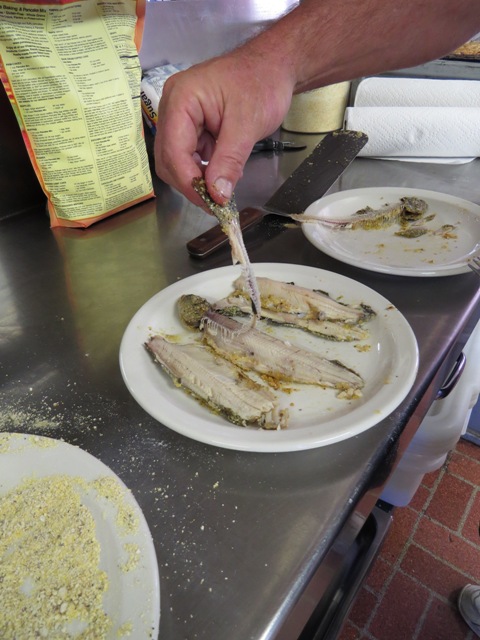
Trout
Drinks
Drinks were on the menu as well. Some were prepared by the teachers and some were ours. The “Equine Elixr” (Horsetail Mint tea) was ours. I am not a fan of Horsetail Mint and neither were my fellow students. We had a quite different name for the concoction…
Left to right: Dandelion wine, Plum wine, Elderberry wine, Elderflower wine (my favorite):
We made two drinks of our own. Our “Manzanita Mash” was simple: Manzanita berries and water (not pictured). It was simply terrific! You can find my recipe here. We also made our own Elderflower soda. We called it “Elderflower Fizz”. The recipe is Elder flowers, water, honey, and champagne yeast.
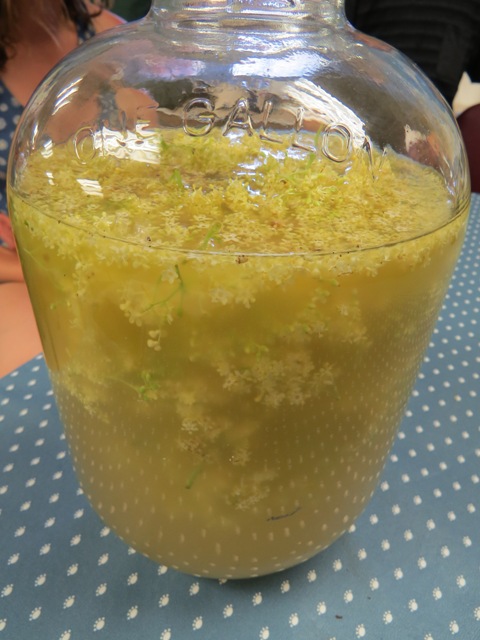
Elderflower Fizz
Seasonings
Seeds were used as seasonings. We had three types of sunflower seeds (Asteraceae). I loved the Yampah seeds – intense carrot!
Clockwise from top: Mountain Sunflower, Yampah, Arrowleaf Balsamroot, Mule’s Ears
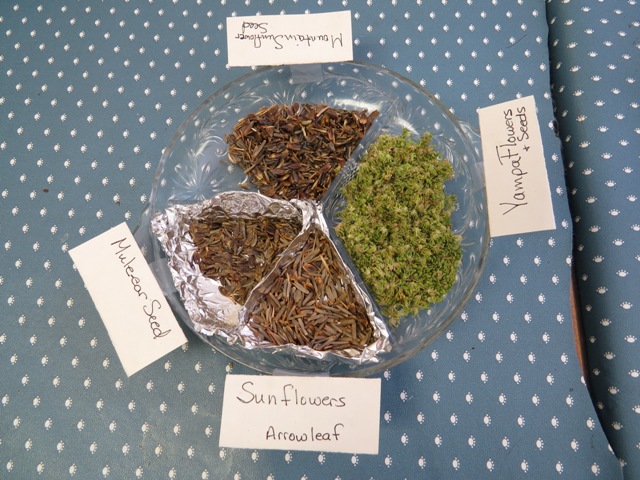
Wild seeds provide seasonings
Although we did not eat it, the experience of digging Soap Plant was exhausting and invigorating. In the Sierras, that is one deep %$# root!
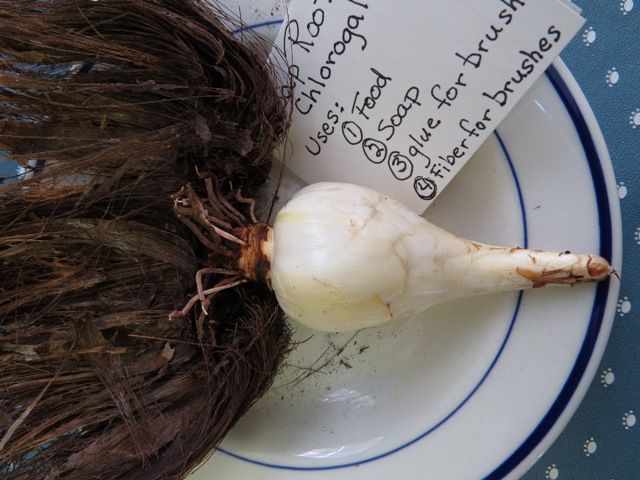
Soap root
Some miscellaneous items…
Vegetarian pemmican (we can cook better than we can spell) 😀
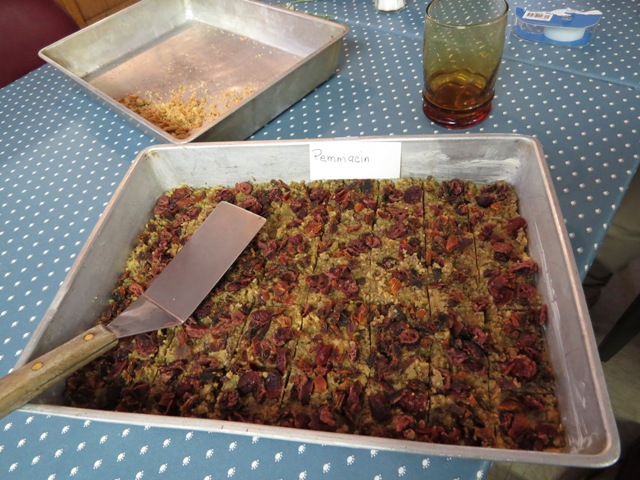
Pemmican
It turns out real bushcrafters *do* eat quiche! At least when it contains Swamp Onion and Bolete mushrooms. (Decorated with Yarrow blossoms)
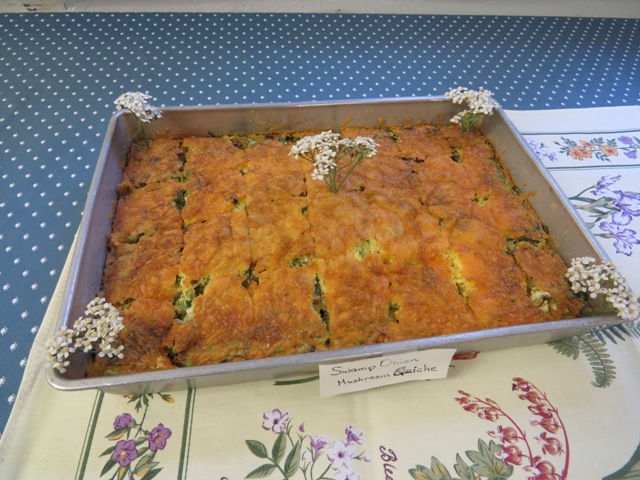
Quiche
I enjoyed eating raw Fir tips as we hiked. For the meal, we pickled them in apple cider vinegar. They were OK…
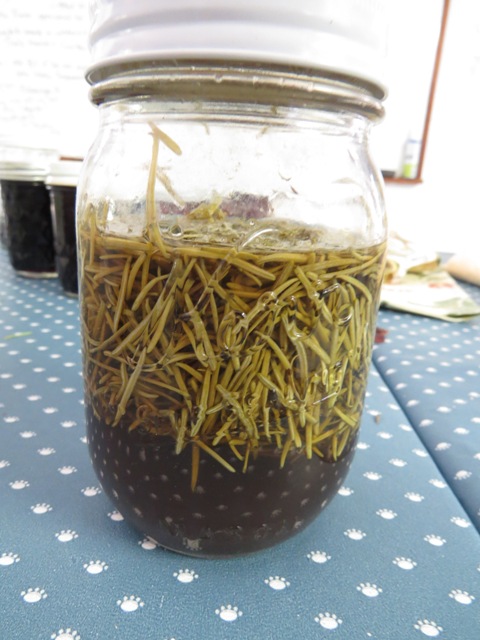
Fir tips (pickled)
As a “serious” bushcrafter, I think about shelter, fire, water, and food. I sometimes forget the “crafts” in bushcraft that can enrich our outdoor experiences. We gathered wild flowers to make decorations for the dishes and each table. Here is a sample we put together for a table. It lent a festive atmosphere to an already fun meal.

Wildflowers
In the future, I plan to post more about obtaining and processing specific plants.
Hopefully this post has stimulated some ideas and some appetites. What is your favorite wild edible, and why? Bon Appetite!
More Edibles on NatureOutside
How to Make Acorns into Food (Part 1)

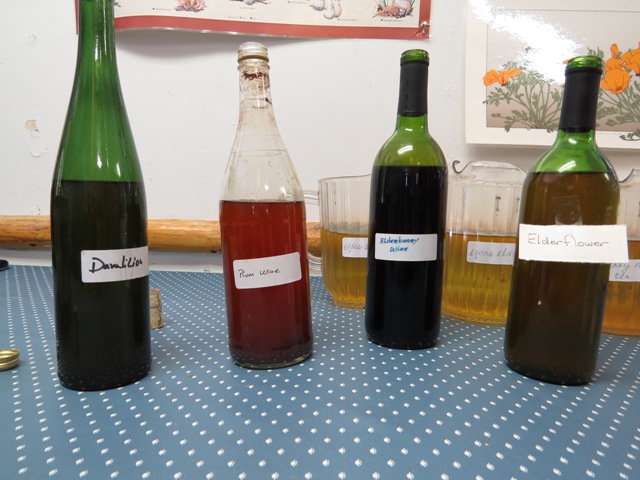


My favorite wild edible (besides meat) is likely ramps, Allium tricoccum. They’re really delicious, and taste like shallots.
Great choice, Xiphias! I love finding wild onion (Allium sp.) when I’m hiking here in California. I always stop to savor their sharp, pungent taste.
I’d love to connect! I live in North Carolina, but I’d love to hear/know if you have recommendations for resources for me (online or in person).
Jenna, one book I recommend is “Nature’s Garden” by Samuel Thayer. I recommend it in this article. You should also look at books by local authors who talk about plants local to your area. Good luck!